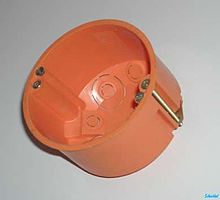Cavity wall box
In electrical installations, the cavity wall socket is a switch box or junction box for use in walls with cavities, for example walls made up of plasterboard . Cavity wall sockets are used, for example, to install switches and sockets . The standard diameter is 68 mm. There are also smaller (e.g. 35 mm) and larger (e.g. 74 mm) diameters, these sockets are then used as outlet sockets for lights or as junction boxes.
On the back of the cavity wall socket there are cable inlets of different sizes for the introduction of cables of different thicknesses . The cavity wall socket is attached with two clamping screws or metal claws on the sides (the designation differs depending on the provider). Cavity wall boxes are available in depths from 35 mm to 65 mm.
Cavity wall boxes are usually made of flame-retardant material and then have a corresponding marking according to VDE 0606 (see picture).
For special requirements in terms of thermal insulation when building houses, there are also windproof boxes, as well as for increased fire protection special boxes made of material that automatically closes the cable openings in the event of fire.
See also
literature
- Alfred Hösl, Roland Ayx, Hans Werner Busch: The electrical installation in accordance with regulations, residential construction, commercial industry. 18th edition, Hüthig Verlag, Heidelberg, 2003, ISBN 3-7785-2909-9
Individual evidence
- ↑ Kaiser-Elektro: Brandschutz ( PDF ( Memento of the original from July 1, 2015 in the Internet Archive ) Info: The archive link has been inserted automatically and has not yet been checked. Please check the original and archive link according to the instructions and then remove this notice. )

